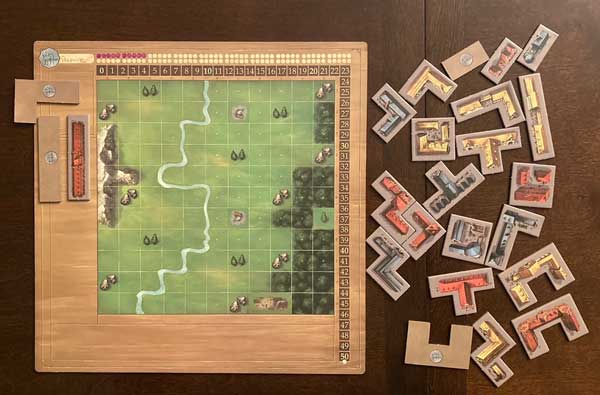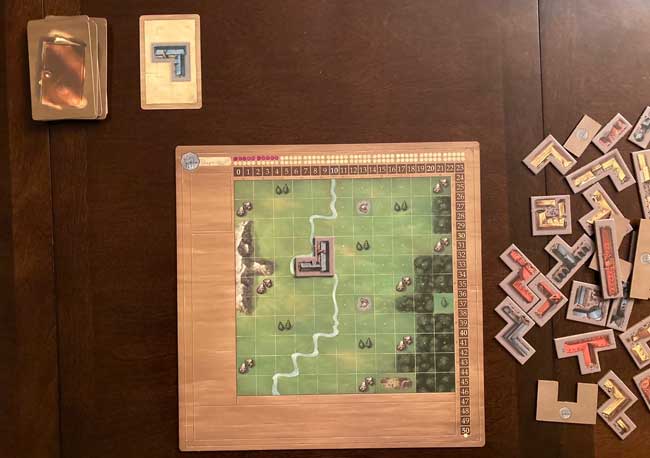My City is a game published by KOSMOS. The premise of the game is for players to take on the role of builders, who after a long journey, work to develop their new city. My City is a legacy game that can also be played as a one-time game in eternal mode. When all of the buildings have been used, or all players can no longer place buildings, the game end is triggered. In legacy mode, the player with the most points is declared the winner and players gain benefits unique to that episode in order of who has the highest number of points. In eternal mode, the player with the most points is declared the winner.
This post is broken into the following 3 sections, feel free to jump directly to one:
- General summary - consisting of information about overall enjoyment, theme, replayability, and upgrades
- Complexity - consisting of information about the rulebook, setup, player turns, and overall learning curve
- Player turns - consisting of game type, game flow, rule you are likely to miss, and favorite aspect
General Summary
Number of players we had: 4
Our play time (not including setup): 30 minutes
Overall enjoyment

Overall our group really enjoys playing this game. My City can be set up quickly, is easy to learn and teach to others, and has a randomness to it that keeps each game fresh. Game play is part luck, as players never know which building they will need to place next, as well as requiring a decent amount of planning as players need to leave space for larger pieces and to gain specific bonuses.
My City is a legacy game, which means the game changes during play sessions. One of the cool things about this is how the rules start out simple so the game can be learned quickly and players can jump right in. Over time, more rules are added to the base foundation, the game board changes, and other additions are made, steadily increasing the complexity of the game.
There are eight different chapters to the legacy game and each chapter is broken into three episodes for a total of 24 episodes. Each episode, in addition to games played in eternal mode, can be played in about 30 minutes.
One of the best aspects of this game is that players can easily play a game, with the same or different players than the legacy game, without interrupting the legacy game play. Player boards are double-sided with one side dedicated to legacy play and the other available for playing in eternal mode at any time. This is not the case in all legacy games, so this is a nice benefit to My City.
If we had to find something that frustrated us about this game it would be that some of the larger buildings can be cumbersome to place, both very early on in the game and also towards the end of the game. However, this is also part of the challenge and in most cases, you can choose to skip a construction by taking a point loss.
Theme

The theme of My City is building structures using randomly revealed polyomino shapes. The theme carries across the tiles and player boards and extends much like a real developing city would throughout the episodes of the legacy game.
Each player has their own player board and matching set of polyominoes. Each polyomino has an animal character that matches the player boards on one side and a building to construct on the other side. Player boards also have obstacles players must work around, like any city would, and a scoring system built into each player board.

Replayability

My City has a decent amount of replayability for two main reasons. First, legacy games introduce new items as you play, making each game slightly different and unpredictable. Play sessions have the potential to bring new rules, options, tokens, ways to win, obstacles, rewards and more. Additionally, some introductions will be permanent, while others are short-lived. Not knowing what will happen next engages players and requires them to pay greater attention to each game.
Second, in addition to being a legacy game, this game can be played during or after the legacy portion, without interfering with the legacy game. This is not true with all legacy games so it definitely adds to the replayability.
Upgrades
I am not aware of any upgrades for this game.
Complexity
Rule book
The rule book is well organized and has great image examples of the game play. The rule book explains how to begin playing a legacy game, and additional rules are introduced later in the chapter envelopes. Luckily, the additional rule sheets included in each chapter build upon one another so you only need to keep the newest one in addition to the rule book. Lastly, the second section in the rule book explains how to play a game in eternal mode.
Setup
My City takes about five minutes to set up. Players take a player board with a matching set of polyominoes and a score cube marker. Once all of the construction cards have been shuffled, the game is ready to begin.
When playing a legacy game, there is often a small introduction to the episode that can be read. Also, it is a good idea to remind players of the added rules if you have not played recently. These rules often affect scoring and it is important to remember exactly how they work.
Turns
Player turns consist of a single action and are taken simultaneously. A construction card is revealed and all players locate that building in their set and place it on their board together. This means turns go quickly, especially in the beginning. As the game goes on, turns take a little longer as players try to find the best way to place buildings or decide to pass on that structure and take a point deduction.

Overall learning curve
The learning curve of this game is very low. There are few rules in the beginning of the legacy game and when playing the eternal game. Also, the rules are not overly complicated so new players can easily pick up the game. Lastly, because everyone is playing with the same rules and always doing the same action, teaching this game to new players is quick.
When playing in legacy mode, players are able to learn the game with fewer rules and add to their play experience over time, which is easier than if they tried to learn all the rules that exist at the very end from the start.
Player Turns
Play type
My City is a legacy game that has elements of grid coverage and tile placement using polyominoes. While it begins as a symmetrical game, it does change over time when playing in legacy mode. These changes are often based on how well players did in a specific episode, but I will not reveal specifics here so it does not ruin the surprise. Playing in eternal mode using the second side of the player board will always be symmetrical.

Game flow
The game flows very quickly because all players are taking the same action each turn and at the same time. A new building is revealed and players then find it and place it on their board.
Rule you are likely to forget/miss
We did not really forget any specific rule in this game, but rather found that newer rules were easier to confuse. For instance, certain rules add extra points by placing certain buildings around items in a certain way. It is important to understand exactly what these requirements are - number of buildings versus building colors, etc. - to capitalize on the additional points. This is why I suggest you refresh players with a reading of the more recent rules before beginning a legacy episode to make sure everyone remembers how specific scoring elements work.
Favorite aspect
Our favorite aspect of this game is that everyone begins with the same opportunity and the same buildings to place, yet everyone's boards will be built differently. Over time, player boards change and other things will affect their game, which I will not reveal here so as not to ruin any surprises! Just know that while everyone begins with the exact same player board and buildings, this will change over time and these changes affect your game play.
When I purchased this game I knew it was a legacy game and had no idea it could also be played as a one-time game. Finding out that it could also be played without interrupting the legacy game was a bonus I did not expect. As a result, I will keep the game long after the legacy portion is over since it is a great game for families, new players, and any player group!


